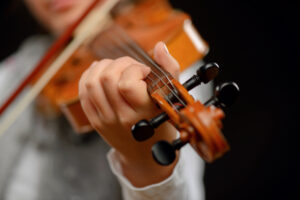 The violin is one of the most common instrument beginning students try. That is why here in Houston, violin lessons are our most popular classes. As you might be looking into getting a violin to start lessons, or if you have heard terms in relation to the violin, here is a description of the instrument and special terms often used to describe the different parts.
The violin is one of the most common instrument beginning students try. That is why here in Houston, violin lessons are our most popular classes. As you might be looking into getting a violin to start lessons, or if you have heard terms in relation to the violin, here is a description of the instrument and special terms often used to describe the different parts.
The Violin
The violin has two main parts, the neck and the body. The top of the violin is called the scroll, which is usually in a spiral but can be carved into different shapes. The peg box holds the ends of the strings and the four pegs, which are made out of ebony. The pegs turn to lengthen or shorten the strings to tune the instrument. The neck of the violin is the long piece of wood that connects the scroll and pegs to the body of the instrument. On top of the neck, a longer piece of wood, also ebony, is glued to the neck and extends over the body of the instrument. This is called the fingerboard and is where the pitches change depending on where the player places their fingers. At the base of the fingerboard, a raised piece of ebony, called the nut, sits in between the main part of the fingerboard and the peg box. The strings from the peg box rests on the nut, which lifts them above the fingerboard, allowing the string to be shortened with the fingers.
The Strings
The strings also rest on another arched piece of wood, which further holds the strings above the fingerboard. The arch also allows the player to play on each string individually. The strings rest on the bridge and attach to the tailpiece, which is usually made out of ebony as well. The tailpiece connects to the main portion of the instrument. In addition, the tailpiece often has fine tuners to allow for smaller corrections in lengthening or shortening the strings to tune them. The tailpiece is connected to the body of the instrument by the end button. Beside the tailpiece is the chinrest where the player will put their chin or jaw to hold the violin in place.
The Body
The body of the violin is often made from spruce and maple wood. The top plate is usually made of spruce, and the back plate is usually maple or another type of harder wood. The back can be made of two pieces of wood or made with a solid back. The edges are called bouts. The top bouts next to the fingerboard are the shoulders of the instrument. The center bouts curve inward around the bridge, and the lower bouts form the base of the instrument near the chinrest. The sides of the violin are called the ribs and connect the top plate with the bottom plate. On the top plate, the sound holes, or F holes, allow the sound to project out of the body of the instrument. Inside the instrument, a dowel connects the top and bottom plate close to the bridge. This is called the sound post and allows the instrument to vibrate and to produce a sound.
The Bow
The bow can be made out of wood, carbon fiber, or fiberglass. The end of the bow is called the tip, and the bottom part is called the frog. The frog is usually made of ebony and provides a place to hold the bow. A leather or plastic grip is located right above the frog and allows for an easier bow hold. The screw at the end of the frog tightens and loosens the ribbon of horse hair connects the two ends. Rosin is applied to the hair to make the hair stickier and to allow the bow to create even more friction against the strings to make a sound.
Contact Us!
Learning the parts of the violin is a great guide to start playing the violin. If you are interested in learning more about the violin or if you want to sign up with a Houston violin teacher, we’re here! At Lessons In Your Home, our instructors are thoroughly vetted, professional, and passionate about music. Our teachers will come right to your home for every lesson, plus we offer virtual music lessons, too. Our online music lessons are taught by local music teachers who plan their lessons to suit your child. Contact us today to learn more.
By Abigail Bracewell
